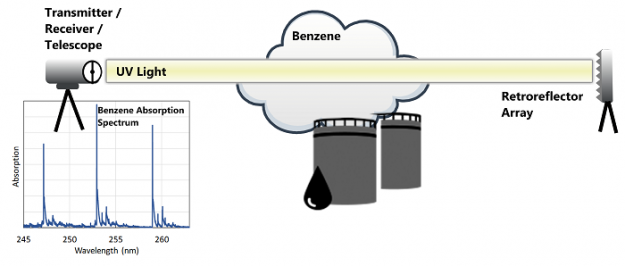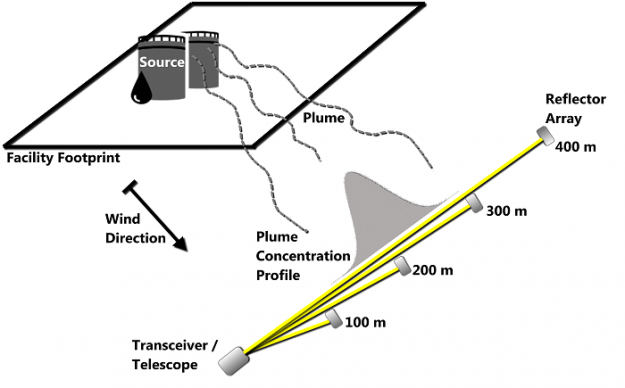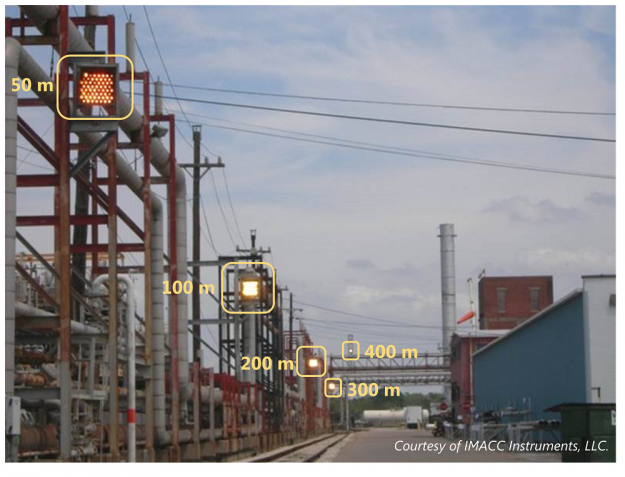Refinery Fenceline Monitoring Data of Concern: Now What?
Posted: February 14th, 2017
Author: All4 Staff
 In the December 2016 edition of 4 The Record (4TR), Nick Leone of All4 Inc. (ALL4) provided insight on where facilities that are subject to the Petroleum Refinery Sector Rule in 40 CFR Part 63, Subpart CC (National Emission Standards for Hazardous Air Pollutants from Petroleum Refineries or Refinery NESHAP) should be in preparation for the benzene fenceline monitoring requirements of the rule. In this 4TR Guest Article, Dr. Volker Schmid of CleanAir Engineering (CleanAir) provides additional insight regarding options to evaluate benzene concentrations of concern that may have been measured during a facility pilot monitoring program. Dr. Schmid is a Business Leader with CleanAir and is the technical lead of CleanAir’s Advanced Monitoring Group. He is responsible for the identification of innovative measurement technologies and their incorporation into services or products offered by CleanAir. He can be reached for questions or comments at vschmid@cleanair.com or at 724.227.0148.
In the December 2016 edition of 4 The Record (4TR), Nick Leone of All4 Inc. (ALL4) provided insight on where facilities that are subject to the Petroleum Refinery Sector Rule in 40 CFR Part 63, Subpart CC (National Emission Standards for Hazardous Air Pollutants from Petroleum Refineries or Refinery NESHAP) should be in preparation for the benzene fenceline monitoring requirements of the rule. In this 4TR Guest Article, Dr. Volker Schmid of CleanAir Engineering (CleanAir) provides additional insight regarding options to evaluate benzene concentrations of concern that may have been measured during a facility pilot monitoring program. Dr. Schmid is a Business Leader with CleanAir and is the technical lead of CleanAir’s Advanced Monitoring Group. He is responsible for the identification of innovative measurement technologies and their incorporation into services or products offered by CleanAir. He can be reached for questions or comments at vschmid@cleanair.com or at 724.227.0148.
Introduction
With the promulgation of the Refinery NESHAP, facilities that are subject to the rule are required to implement a fenceline monitoring program for benzene with a passive sampling approach using sorbent traps. The compliance timeline for fenceline monitoring does not commence until January 30, 2018. However, many affected facilities have elected to operate passive fenceline samplers as part of pilot studies aiming to assess current ambient benzene levels and evaluate operational trends and seasonal variations in fugitive emissions.
As the number of facilities performing pilot studies has increased, it has become evident that measured ambient benzene concentrations can vary considerably and can reach levels of concern. The regulatory corrective action trigger level of 9 mg/m3 (2.8 ppb) set in the Refinery NESHAP represents the concentration difference between the highest and lowest passive sampler results on the fenceline, effectively correcting the fenceline results for background concentrations. Therefore, an investigation into ambient benzene concentrations of concern will not only have to involve the search for sources within the refinery premises, but may also include sources outside the refinery contributing to the benzene background.
Investigating the root causes of ambient benzene concentrations of concern can be a difficult task when relying on the time-integrated passive sampler results, which represent an average concentration for a 14-day sampling duration. During this period, the gaseous benzene in the air surrounding the sorbent trap in the sampler migrates onto the sorbent at a well-defined uptake rate. This pre-concentrates the sample on the sorbent and results in a highly sensitive measurement with detection limits below 0.1 ppb. However, this sensitivity comes with a compromise, limited temporal resolution, which makes it inherently difficult to locate sources of transient leaks and fugitive emissions. The problem is further compounded by wind direction variability during the extended sampling period, leading facility personnel often wondering what steps to follow when investigating measured ambient benzene concentrations of concern.
Real-time data generating methods
One tool to identify the often transient fugitive emission sources within or outside of an affected facility is to collect time-resolved, real-time concentration data using fenceline monitoring systems. One such approach uses monitors that measure benzene concentrations from one or more discrete points along the fenceline. An example of such a system uses thermal desorption gas chromatography followed by either flame ionization or photoionization detection. This analytical approach can be selective to benzene and has a sensitivity that is comparable to those achieved with the passive sampling approach. However, the spatial and temporal representation of this approach is limited by the number of individual points being measured along the fenceline and the typically lower data update rates associated with gas chromatography, respectively.
Alternatively, there are optical remote sensing methods that measure average pollutant concentrations along an entire linear distance. These “open-path” systems can provide measurements that are representative of benzene concentrations along a section of the fenceline up to several hundred meters in length. Such systems have received much attention for this application due to their promise of comprehensive fenceline coverage and much more frequent data update rates than those of some of the single-point monitors. One of the more prominent optical remote sensing methods being considered is based on Differential Optical Absorption Spectroscopy in the Ultraviolet region of the spectrum (UV-DOAS). In its implementation as an open-path fenceline monitoring system, UV light is transmitted through ambient air towards a retroreflector array consisting of multiple individual mirrors. The mirrors reflect the light back to a detector where it is spectrally analyzed. Benzene molecules in the traversed air mass absorb light in the UV at very specific wavelengths. The resulting absorption spectrum and corresponding benzene concentrations are derived during spectral analysis. Figure 1 illustrates the open-path UV-DOAS approach.
Figure 1. Schematic of an Open-Path Monitoring System
Selection Considerations
The single-point as well as open-path monitoring methods are technologically advanced systems. Their selection and use require numerous consideration and compromise. Attempting to implement complete fenceline coverage for an entire facility with either approach can become cost-prohibitive very quickly. Sensitivity is another consideration. While recent research and development efforts have increased the sensitivity of optical remote sensing systems such as open-path UV-DOAS, the current detection limits of most UV-DOAS systems are about 1 ppb in a 100-meter optical path. While this provides for a highly sensitive measurement, it is not sufficient to use these systems for continuous compliance monitoring.
With a corrective action trigger level of 2.8 ppb of benzene required by the Refinery NESHAP, a detection limit of 0.3 ppb or less is desirable. This favors pre-concentrating single-point monitors because they can provide the necessary sensitivity. However, the low data update rates and limited fenceline coverage restricts its use in this application.
Benefits of Open-Path Systems
Ultimately, the current sensitivity, specificity to benzene, ability to provide frequent data updates, and a larger fenceline coverage with a single system can make open-path UV-DOAS systems a useful diagnostic tool. For example, they can be used to help determine root causes when time-integrated passive sampler data show ambient benzene concentrations of concern at the fenceline. Such data is especially helpful when trying to distinguish between nearby and upwind sources of benzene emissions from outside the facility that contribute to background concentrations. Contributing sources can include neighboring industrial facilities, fueling operations, combustion sources, as well as nearby highways or roads. Because many contributing sources generate transient short-term emissions, the rapid response from a UV-DOAS system can help to identify their location when paired with local meteorological data. In fact, this approach can be used to locate and map ground-level plumes by positioning the optical path of the instrument in the vicinity of suspect contributing sources or by installing multiple retroreflector arrays for a finer spatial resolution of the measurement. In conjunction with real-time meteorological data, this approach can form the basis for a back-trajectory analysis to locate the contributing sources. A schematic of such a ground-plume locating setup using open-path technology and a permanent implementation of that concept at a petrochemical plant is shown in Figure 2.
Figure 2. Ground-Level Plume Location Detection
So what about those concentrations of concern at my fenceline?
This leads back to the initial question: I have performed a fenceline monitoring pilot study using passive samplers and measured ambient benzene concentrations of concern. What can I do now?
First of all, although the compliance date is still a year away, it is prudent to investigate the origin of measured ambient benzene concentrations of concern to clarify the emissions profile of the facility and to identify possible contributing sources, both inside and outside of the facility. In addition, measured ambient benzene concentrations of concern can indicate process leaks and result in a loss of product, or under some circumstances lead to potentially unsafe working conditions. Secondly, when compliance monitoring begins next year, the concentration difference between the sampler result and the background levels, will determine if corrective action is triggered. Therefore, before embarking on a possible expensive investigative journey, there is need to correct the passive sampler results in question for background levels.
Here are some additional suggested actions to consider during the investigative process.
- Validate passive sampler results by investigating quality control parameters. Check the sample chain-of-custody transfer sheets for an unbroken chain of custody and for consistency. Passive sampler results are as much a function of sampling location as they are of measurement errors due to potential deployment, handling and analytical errors.
- Critically evaluate and isolate background contributions. Evaluate the location of potential background contributors with respect to the location of the passive sampler, taking into consideration prevailing local wind conditions during the sampling event. Investigate unusual local meteorological conditions that could have led to contributions from unexpected interfering sources. Background contributions can originate from transient nearby as well as cumulative far-field sources. Consider adding extra passive samplers around suspected sources to allow for better spatial resolution to isolate background contributions.
- Once the data are established to be of sufficient quality and ambient benzene concentrations of concern are verified to have originated from within the facility, consider adding extra passive samplers around suspected sources to improve spatial resolution, which will help to identify facility hot spots. Look for neighboring sample locations with significantly different measurement results and add extra passive samplers.
- Reconcile measured results at the location of interest with operational, maintenance and safety logs, as well as other relevant process documentation. Consider local wind conditions during the sampling event. Also consider increasing passive sampling frequency to allow for better temporal resolution of contributing emission sources.
- If the passive sampling results and associated local meteorological data do not clearly identify facility contributions to ambient benzene concentrations of concern, consider targeted diagnostic monitoring using time-resolved, real-time data generating fenceline monitoring systems such as open-path UV-DOAS. Emission contributions can be transient. Accordingly, real-time monitoring instrumentation can provide valuable information about the extent of the plume at ground level. The same approach can help locate interfering transient background sources.
- Choose real-time fenceline monitoring paths that provide enough spatial resolution and sensitivity to perform a trajectory analysis that identifies the emissions source. Enlist the appropriate facility internal resources to respond to ambient benzene concentrations of concern during enhanced monitoring studies.
Conclusion
The initiation of benzene fenceline monitoring at affected petroleum refineries for compliance purposes is January 30, 2018, less than one year from now. Many affected petroleum refineries have already completed trial programs to evaluate ambient benzene concentrations at the fenceline and to gauge contributions from neighboring facilities, combustion sources, as well as nearby highways or roads to the fenceline results. Contributing local sources as as well as facility-specific fugitive emissions can be transient in nature and difficult to resolve and identify using the time-integrated measurement results of passive samplers.
Time-resolved real-time monitoring systems such as open-path UV-DOAS can provide a useful diagnostic tool for identifying and isolating transient background or facility-specific contributions to the fenceline results. Installing a real-time monitoring system at sections of facility boundaries that have shown repeated ambient benzene concentrations of concern can be of value for mapping the plume and identifying contributing sources. The ultimate goal is to understand the emission profile of the facility and to identify local contributing sources outside of the facility well ahead of compliance deadlines.



